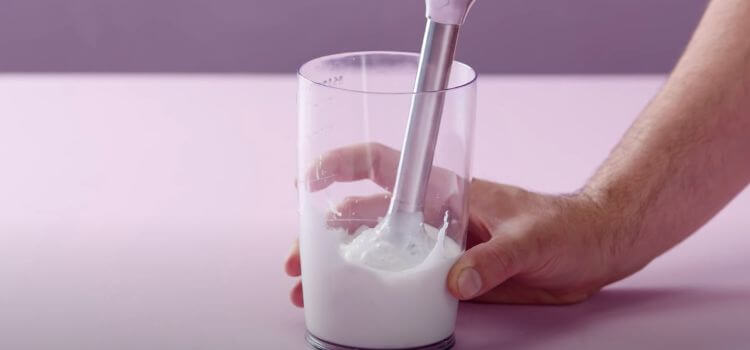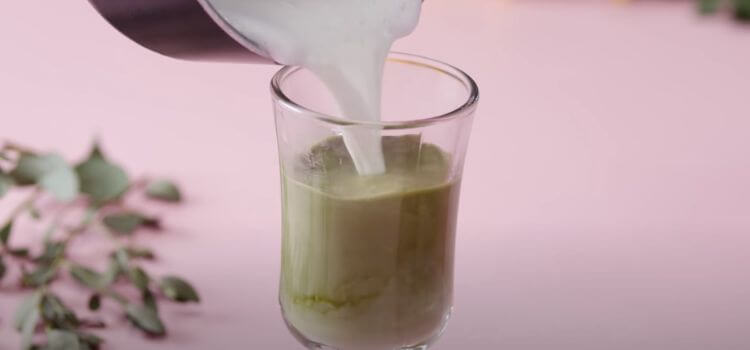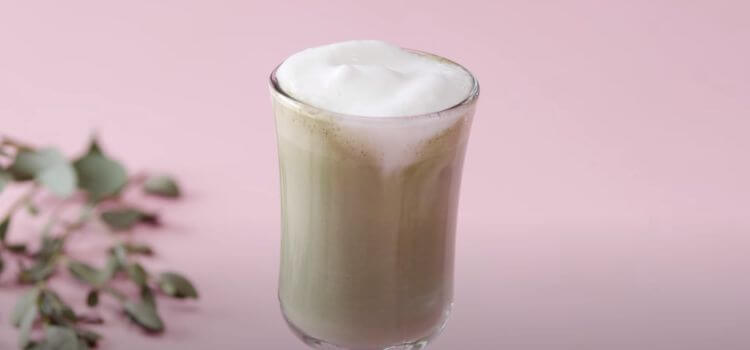In the bustling world of kitchen appliances, one tool that continues to gain popularity and prove its versatility is the immersion blender.
This handheld device, also known as a stick blender, has become a staple in many kitchens due to its ability to effortlessly blend, puree, and emulsify a variety of ingredients.
From creamy soups to smoothies and sauces, the immersion blender is like a secret weapon for achieving the perfect texture in countless recipes.
But have you ever wondered if this multifunctional gadget can go beyond its usual tasks? In today’s blog post, we delve into the intriguing question: Can you froth milk with an immersion blender? Stay tuned to uncover the answer and unlock a new realm of possibilities for your culinary creations.
What is Frothing Milk?

Frothed milk is a popular technique used in the preparation of various beverages, predominantly coffee-based ones like lattes, cappuccinos, and macchiatos.
The process involves aerating the milk to create a thick, creamy texture and a layer of fine bubbles on top. Frothed milk not only adds a visual appeal to these beverages but also enhances the taste and overall drinking experience.
The Process of Frothing Milk:
To froth milk, the traditional method involves using a steam wand on an espresso machine, which introduces steam and heat to the milk to create the desired effect.
However, an emerging alternative to this method is using an immersion blender. An immersion blender, also known as a hand blender or stick blender, is a handheld kitchen appliance consisting of a motorized blade that is immersed directly into the milk.
Using an Immersion Blender to Froth Milk:
Many coffee enthusiasts wonder if an immersion blender can effectively froth milk compared to the more conventional steam wand method.
The answer is yes, an immersion blender can indeed produce frothed milk, although the technique may require some practice and specific considerations.
First and foremost, it is crucial to use a container that is appropriate for blending hot liquids. Ideally, a tall and narrow container with sufficient depth can help contain the milk and prevent splashing or spilling.
Additionally, selecting the right type of milk is important, as different kinds of milk can react differently when blended. Whole milk is typically the best choice for achieving the desired frothy consistency.
When using an immersion blender, it is recommended to start with warmed milk, as frothing cold milk can be more challenging. Simply heat the milk in a microwave or on the stovetop until it reaches your desired temperature.
Then, lower the immersion blender into the milk, ensuring the blades are completely submerged, and blend for about 20 to 30 seconds. The speed and movement of the blender can influence the thickness and texture of the frothed milk, so experimenting with different techniques may be necessary to find the ideal result.
The Importance of Frothing Milk:
In beverages like lattes and cappuccinos, frothed milk not only enhances the aesthetic appeal but also contributes to the overall sensory experience.
The combination of the velvety texture and sweet creaminess of frothed milk creates a pleasant mouthfeel and complements the flavors of the coffee. Moreover, frothed milk acts as an insulator, helping to preserve the temperature of milk.
Pros of using an immersion blender for frothing milk:

Frothing milk can be a delightful addition to your morning coffee or a fancy touch to your homemade cappuccinos. While there are many methods to achieve the perfect froth, one tool that often goes overlooked is the immersion blender.
Often praised for its versatility and convenience, an immersion blender can be surprisingly effective at frothing milk.
One of the greatest advantages of using an immersion blender for frothing milk is its ease of use. Unlike other frothers that require manual pumping or complicated machinery, an immersion blender simply requires immersing the blending wand into a cup of milk and turning it on.
This simplicity makes it an excellent choice for those who prefer a quicker and fuss-free frothing experience.
Another benefit of using an immersion blender for frothing milk is its ability to create a rich and creamy texture.
The blender’s powerful motor and rotating blade create a vortex in the milk, incorporating air and creating small bubbles that give the froth its desirable lightness. The result is a velvety, dense foam that adds a delightful touch to any beverage.
In addition to its simplicity and texture, an immersion blender offers versatility in terms of the types of milk it can froth. Whether you prefer dairy milk, plant-based alternatives like almond or soy milk, or even cream, an immersion blender can handle them all. This makes it a fantastic option for those with dietary restrictions or personal preferences.
Another advantage of using an immersion blender for milk frothing is its compact size and easy storage. Unlike bulky and space-consuming frothers or steam wands, an immersion blender can easily fit into any kitchen drawer or cabinet. This makes it ideal for those with limited counter space or for those who prioritize a clutter-free kitchen.
So, can you froth milk with an immersion blender? Absolutely! With its simplicity, texture, versatility, and compact size, an immersion blender is a great tool to achieve the perfect froth for your favorite beverages. Whether you enjoy a frothy cappuccino, a creamy hot chocolate, or a delicious latte, the immersion blender can elevate your at-home coffee experience to the next level.
Cons of using an immersion blender for frothing milk:
When it comes to frothing milk, using an immersion blender may not be the most ideal option for everyone. While immersion blenders are versatile and convenient kitchen tools, there are a few limitations and drawbacks to consider when using them for frothing milk.
1. Aerating Ability: One of the main limitations of using an immersion blender for frothing milk is its ability to aerate the milk properly. Traditional milk frothers or steam wands on espresso machines are specifically designed to introduce air into the milk, creating those coveted creamy foam bubbles.
Immersion blenders, on the other hand, may not be able to achieve the same level of aeration, resulting in a denser and less airy foam.
2. Control and Precision: Another drawback of using an immersion blender is the lack of control and precision in frothing milk. Immersion blenders are typically designed for larger quantities and can make it difficult to achieve consistent and uniform froth throughout the milk.
This can be particularly challenging if you are aiming for latte art or specific textures in your frothed milk.
3. Noise and Splash: Immersion blenders can be quite loud and generate a significant amount of noise when in operation. This can be disruptive, especially if you are making your morning coffee in a shared living space or early in the morning. Additionally, the high-speed blending action of an immersion blender can cause splashing.
Tips for Frothing Milk with an Immersion Blender

An immersion blender is a versatile and convenient tool that can be used for a variety of kitchen tasks, including frothing milk. Whether you want to add a frothy topping to your latte or create a creamy foam for your cappuccino, an immersion blender can be a handy tool to have. Here are some tips and step-by-step instructions for achieving the best froth using an immersion blender.
Step 1: Choose the right container for frothing the milk. It is recommended to use a tall, narrow container that will allow the blender to create a vortex as it blends. This will help create more foam and prevent the milk from splattering everywhere.
Step 2: Warm the milk. To achieve the best froth, it is important to start with warm milk. Heating the milk to around 140°F (60°C) will help create a better froth compared to using cold milk. You can heat the milk on the stovetop or in the microwave, but be careful not to overheat it, as overheated milk can affect the quality of the froth.
Step 3: Place the immersion blender in the container with the warmed milk. Make sure the blender is fully immersed in the milk before turning it on. You can use a low or medium-speed setting, depending on the power of your immersion blender. Avoid using the highest speed setting, as this may create too much splashing.
Step 4: Blend the milk in an up-and-down motion. Move the blender up and down in the container to create a whirlpool effect, which will help incorporate air into the milk and create froth. Continue blending until you achieve the desired level of frothiness. This typically takes around 30 to 60 seconds, depending on the power of your immersion blender.
Step 5: Pour and enjoy. Once you have achieved the desired froth, carefully pour the milk into your coffee or beverage of choice. The creamy foam will add a delightful touch to your drink, enhancing both its visual appeal and taste.
Handy Tips:
– Start with a smaller amount of milk initially, especially if you are new to frothing milk with an immersion blender. This will give you more control and prevent spillage.
– Use whole milk or milk with a higher fat content for better frothing results. Lower-fat milk may not froth as well.
– Experiment with different techniques and blending times to find the method.
Recommended immersion blenders for frothing milk

When it comes to frothing milk, having the right tools can make all the difference. One such tool that is often overlooked is the immersion blender. But can you really froth milk with an immersion blender?
The answer is yes, and in fact, using an immersion blender can be a convenient and efficient way to achieve that perfectly frothed milk for your favorite beverages.
There are a few key factors to consider when selecting an immersion blender for frothing milk. Firstly, you’ll want to make sure that the blender has a high-powered motor.
This will allow for smooth and consistent blending, resulting in a velvety froth. Additionally, look for a blender with multiple speed settings, as this will give you greater control over the frothing process.
One immersion blender that comes highly recommended for frothing milk is the Breville BSB510XL Control Grip Immersion Blender. With its 280-watt motor and variable speeds, this blender is well-equipped to handle the task of frothing milk.
Its ergonomic design and comfortable grip make it easy to use for an extended period of time, ideal for those who enjoy making multiple cups of frothy beverages.
Another immersion blender worth considering is the KitchenAid KHB2351CU 3-Speed Hand Blender. This blender boasts a powerful 3-speed motor, allowing for precise control over the frothing process.
Its removable blending arm and versatile attachments make it a versatile tool for various kitchen tasks. Moreover, its sleek design and high-quality construction make it a stylish addition to any kitchen countertop.
For those who are on a budget, the Hamilton Beach 59765 2-Speed Hand Blender is a great option. Despite its affordable price, this blender offers decent frothing capabilities.
With its two-speed motor and stainless steel blending wand, it can effectively froth milk for your cappuccinos or lattes. While it may lack some of the advanced features of more expensive models, it is a reliable and cost-effective choice for occasional frothing needs.
If you’re willing to invest in a high-end immersion blender, the Braun MultiQuick 5 Immersion Hand Blender is a top choice. This blender features a powerful 350-watt motor and multiple speed options, allowing for precise frothing control.
Its unique PowerBell technology ensures smooth and consistent blending results. Additionally, the blender’s comfortable grip and easy-to-use controls make it risk-free.
Alternatives to using an immersion blender for frothing milk
If an immersion blender is not available, fear not! There are alternatives that can be used to achieve frothed milk. One of the most popular options is using a traditional handheld frother.
These small, battery-powered devices are specifically designed for frothing milk and require minimal effort. Another alternative is a French press. By heating the milk in a microwave or stovetop, and then using a French press to plunge the milk quickly, it can create a lovely froth.
Additionally, if you have a coffee grinder with a blade attachment, it can also be utilized to froth milk. Simply add hot milk to a jar, cover it tightly, and shake vigorously for about 30 seconds. Voila! Frothy milk without an immersion blender.
The versatility of an immersion blender
The immersion blender’s versatility makes it an excellent tool not only for blending soups and sauces but also for frothing milk. Its long, slender design and adjustable speed settings allow for efficient blending and frothing.
With a powerful motor, it creates a whirlpool effect, incorporating air into the milk and producing luxurious foam. The stainless steel blending shaft ensures durability and easy maintenance, while the detachable design allows for thorough cleaning.
Common mistakes to avoid when frothing milk with an immersion blender:
Frothing milk with an immersion blender can be a convenient and efficient way to achieve that perfect froth for your morning cappuccino or latte.
However, there are a few common mistakes that can result in subpar froth if not taken into consideration. By knowing what to avoid, you can ensure a smooth and creamy froth every time.
1. Using the wrong type of milk: One of the most common mistakes people make when frothing milk with an immersion blender is using the wrong type of milk. While any type of milk can be frothed, not all types will produce the same results.
Whole milk tends to froth better due to its higher fat content, while skim or low-fat milk may result in a thinner and less creamy froth. For the best results, opt for whole milk or a non-dairy alternative with a higher fat content.
2. Using cold milk: Another mistake to avoid is using cold milk straight from the refrigerator. Cold milk takes longer to heat up and froth, which can result in uneven frothing and a less creamy texture.
To achieve the best froth, let the milk sit at room temperature for a few minutes before frothing. This will allow the milk to heat up more evenly and result in a smoother frothed texture.
3. Overheating the milk: While it is important to heat the milk before frothing, overheating can be a common mistake to avoid. If the milk becomes too hot, it can result in burnt or scalded milk, which will affect the taste and texture of the froth.
To prevent this, heat the milk slowly and keep a close eye on the temperature. The ideal temperature for frothing milk is around 150°F (65°C), so be sure to use a thermometer to monitor the heat.
4. Not using a deep enough container: When frothing milk with an immersion blender, using a deep enough container is crucial to prevent splattering. The frothing process can cause the milk to bubble and expand, so using a container that is deep enough will help contain the froth and prevent any mess.
A tall and narrow container, such as a small pitcher or a deep mug, is ideal for frothing milk with an immersion blender.
Conclusion:
The effectiveness of using an immersion blender for frothing milk is evident. Through our exploration of this concept in today’s blog article, we have seen how this versatile kitchen tool can easily create velvety and creamy froth to enhance our favorite hot beverages.
By simply submerging the immersion blender in a cup of warm milk and blending it for a few seconds, we can achieve cafe-worthy frothed milk from the comfort of our own homes.
The smooth and consistent texture adds a delightful touch to lattes, cappuccinos, and even hot chocolates.
The convenience and ease of use offered by an immersion blender make it an ideal choice for frothing milk.
It eliminates the need for specialized equipment, such as milk frothers or steam wands, and allows us to experiment with different milk types and flavors. Moreover, the clean-up process is quick and hassle-free.
If you have yet to give frothing milk with an immersion blender a try, we encourage you to do so. You’ll be pleasantly surprised by the professional-grade results achievable with this simple yet powerful tool.
With a little practice and experimentation, you’ll be able to create beautifully frothed milk that will rival your favorite coffee shop’s offerings.
Investing in an immersion blender opens up a world of possibilities for coffee enthusiasts and lovers of warm, frothy drinks.
So, why not take the plunge and explore the wonders of homemade frothed milk? Your taste buds will thank you.
Thank you for joining us on this milk frothing journey. We hope you found this article informative and inspiring. Happy frothing!